The importance of keyword research in Google SEO
One of the most fundamental elements of SEO is keyword research. Over 300 is the number of algorithm changes that Google makes on a yearly basis, yet one key element that never changed is the importance of doing keyword research.
Keyword research, at its essence, is market research. It tells you what people are interested in, and in what relative numbers. Better yet, it reveals the actual language people are using when they think about those topics, which provides you with insight on how to converse with them via your content.
Copyblogger.com
At its core, keyword research helps you find out what your target audience is searching for when they are using Google. You can then use the keywords more efficiently in your content creation or updating to better reach your target audience.
What is a keyword when it comes to the subject of SEO?
Moz has spelled what a keyword is in terms of SEO and content writing is wonderfully:
Keywords are ideas and topics that define what your content is about. In terms of SEO, they’re the words and phrases that searchers enter into search engines, also called “search queries.” If you boil everything on your page — all the images, video, copy, etc. — down to simple words and phrases, those are your primary keywords.
Moz.com
What does keyword research help you accomplish
- Find out what your target audience is searching for
- Find out how many people are searching for this
- Effective content creation and page optimization
- Bringing in more traffic to your website
Now that you’ve learned the importance of keyword research, let’s dive into the different types of keywords that drive traffic to your website.
Keyword research: Know your type of keywords
There are 4 types of keywords that will help you in effective keyword research. When fully understood, this concept will help you slide through keyword research seemlessly.
The 4 types of keywords are namely:
- Informational keywords
- Transaction keywords
- Long-tail keywords and
- Short-tail keywords
Actually, there are only 2 main types that are split into 2 subtypes. The 2 main type of keywords are informational or transactional keywords. They are then split into 2 subtypes which are long-tail or short-tail keywords. Let me explain.
Subtype 1: Long-tail keywords
Long-tail keywords are key phrases (keywords) that are made up of 5 words or more. This type of keyword will be the main focus during content creation and page optimization as they are often low in competition, therefore, allowing you to rank easier and quicker, thereby driving traffic to your website at the early stages.
Some examples of long-tail keywords are the following:
- Best bait to catch a grouper
- Where to prawn at Punggol
- Best chicken rice in Ang Mo Kio
Subtype 2: Short-tail keywords
Short-tail keywords are keywords that are made up of usually 2 to 4 words. If your website is new, you should only target long-tail keywords during your content planning as they often comprise short-tail keywords as well. If you target short-tail keywords by themselves only, you may not do so well as your new website has not garnered enough domain authority.
Some examples of short-tail keywords are the following:
- Satay in Singapore
- Cafe in Singapore
Main Type 1: Informational Keywords
Informational keywords are keywords that users may type into Google in order to find general information regarding a certain topic. Typically, they would be who, when, why, what, where and how questions.
Some examples of informational keywords are:
- How to do internal linking for SEO
- What are long-tail keywords in SEO
- What to do at East Coast Park
Main Type 2: Transactional Keywords
Transactional keywords are keywords that users may type into Google usually when they want to make a transaction. Typically, they would be buy, sell, trade queries.
Some examples of transactional keywords are:
- Where to buy baseball caps
- Where to sell second-hand phones
- Where to buy flatfishes
So how do I use these in my keyword research?
Now that you know what are the main and subtypes of keywords in SEO. Let’s go through how you should go about creating a list of keywords for your content planning.
Instead of thinking of keywords off the top of your head, follow our proven system to find keywords that generate traffic for your website.
This is a simple 2-step formula to generating effective long-tail keywords provided to you by Digitaldev.sg
We will start with a short-tail keyword to a long-tail keyword by adding transactional or informational keywords to fulfill the audience’s search intent.
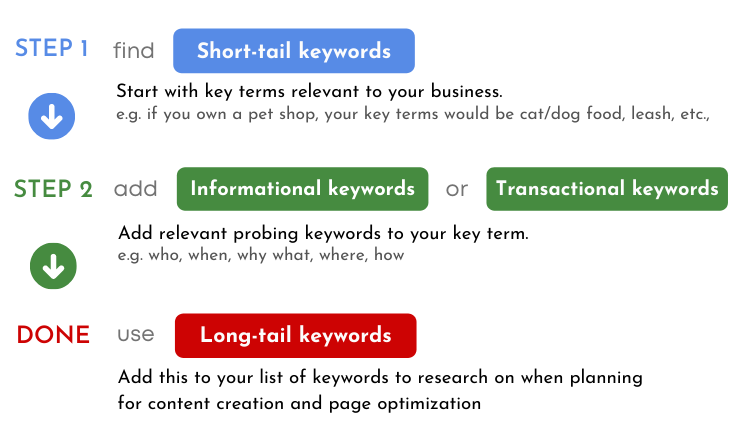
Part 1: Starting with short-tail keywords
Firstly, you have to identify the key terms relevant to your industry. For example if you belong in these businesses:
- Pet shop – cat food, dog food, dog leash, hamsters, etc.
- Aquarium industry – fish tank, fish food, filtration system
- Cafe – croissant, coffee, cake, bread
- Party supplies industry – balloons, costumes
Part 2: Add relevant navigational or informational keywords
Secondly, you’ll have to add relevant informational or transactional keywords to your previously identified key terms, therefore giving you long-tail keywords that match your audience’s search intent. Let’s say you are a florist and your key terms are:
- Bouquet – bouquet for wife birthday, bouquet for wedding anniversary
- Flowers – happy birthday flowers
- So on and so forth
Part 2.1 (Optional): Get Google to assist you
If you’re scratching your head at part 2 and can’t figure out what navigational or informational keywords to add to your key term. Simply throw your key term into Google search and let Google give you ideas and suggestions!
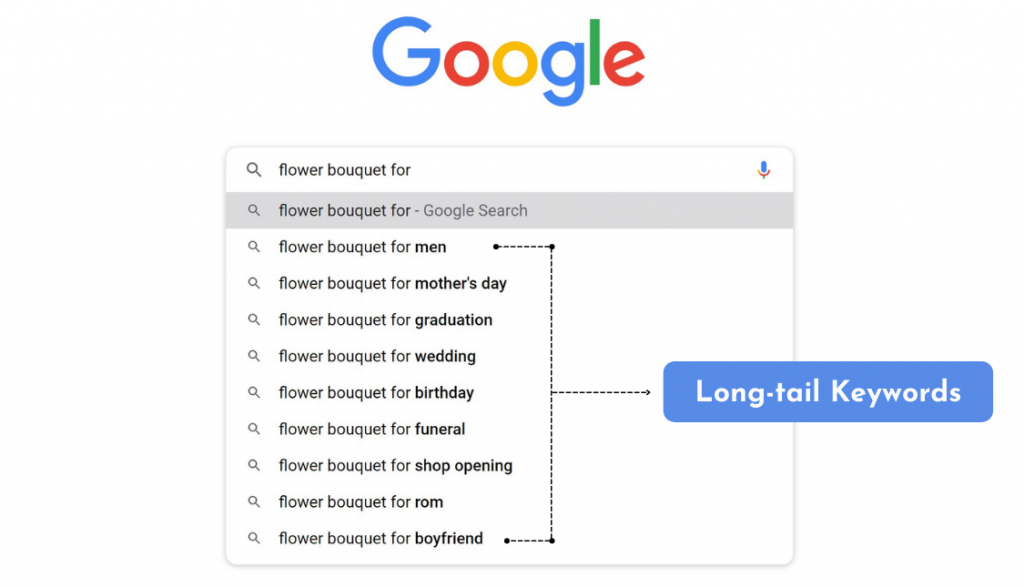
Mind you, these are not generated randomly. The additional keywords you see after pressing in your key term is what users are actually searching for.
This means that these are your ideal long-tail keywords which you can start writing down on your note for the last and final part of keyword research for SEO.
Sizing up your keyword with a Keyword Research Tool
Before we go any further, try to create a list of 20 to 30 long-tail keywords as in this section, you will learn to evaluate your keywords using a keyword research tool to find out if it is a good fit for your content planning needs.
Keyword Research Tools
Here are some free keyword research tools which you can use to evaluate the quality and worthiness of your long-tail keywords:
- Google Keyword Planner Tool
- Semrush (you’ll need to create a free account first)
- Ubersuggest
Today, we will use Google’s Keyword Planner Tool to find out the worthiness of my long-tail keywords. But before that, let me explain what I mean by keyword worthiness.
Keyword worthiness explained
In short, keyword worthiness determines how “good” your keyword is in your content planning. I digress, just because you found a good long-tail keyword that you think many are searching for, doesn’t mean it is worthy.
As a new and small website, you have relatively little domain authority which means it will be hard for you to rank for high competition keywords.
High competition keywords are basically keywords that many sites are trying to target and rank for.
So what makes a worthy keyword?
Given that you have a small site with low domain authority, a worthy keyword would ideally be one with average search volume but low competition.
Read on to find out how to determine whether your keyword is a good fit for your content planning efforts.
Keyword competition and average monthly searches
When it comes to evaluating your keywords, two of the most important things to take note is the average monthly searches and it’s competitons.
As you can see from the below screenshot of Google’s Keyword Planner Tool, the keyword “flower delivery Singapore” has a high average monthly search rate of 10,000 up to 100,000 searches. This is considered a lot of monthly searches for our tiny island that is Singapore.
But does that mean that this keyword is worthy? Read on and find out why this keyword “flower delivery Singapore” is not a worthy keyword and why you should remove this off your list during keyword research.
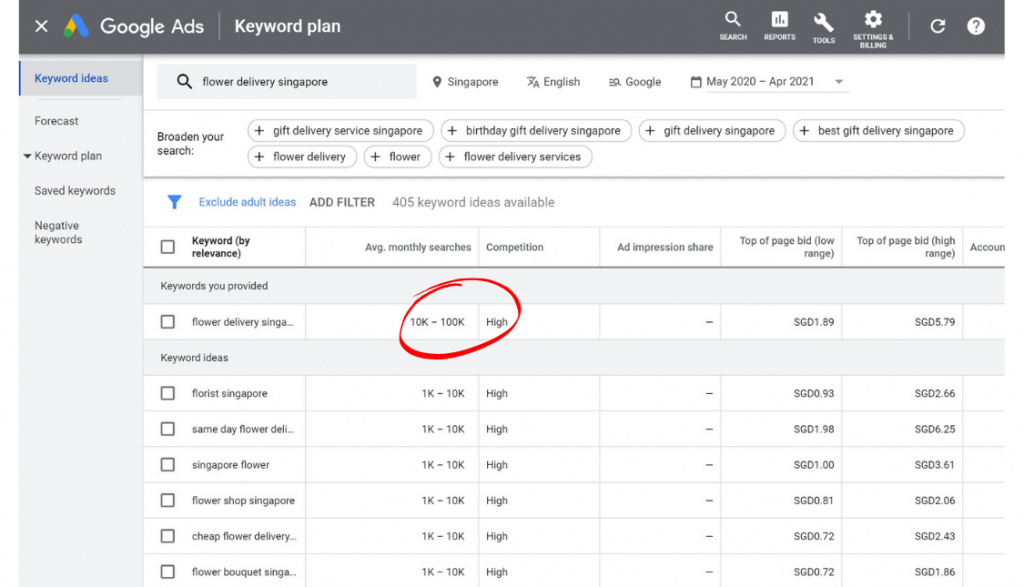
Don’t get me wrong, high monthly searches is a great thing and one should try to find when doing keyword research.
However, that doesn’t make this keyword a good fit for your content planning as it has a high keyword competition. This means that there are many long established websites with much higher domain authority that currently target and compete to rank for this keyword.
So what now? Do I have to completely disregard this keyword and throw it into the trash? The short answer is no.
Adding relevant keywords to your high competition keywords
Instead of completely throwing away this keyword completely, you can add on additional relevant keywords. If you’ve run out of ideas, feel free to use another SEO keyword research. For this example, I will be using Semrush to find another keyword.
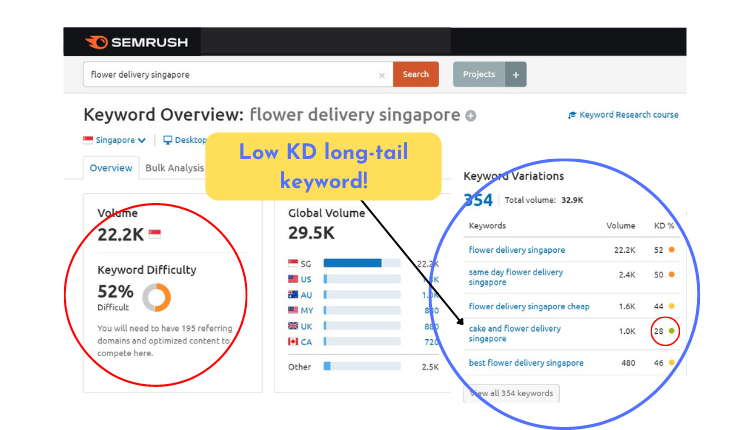
Keyword difficulty as seen in the big red circle can be understood the same way is keyword competition. For “flower delivery singapore” we can see that there is an average of 22,200 monthly searches, with a keyword difficulty of 52%.
Semrush also tells you that you need to have 195 referring domains and optimized contents to compete for this keyword. Referring domains are also known as backlinks which is explained in this article.
We’ve found out low difficulty long-tail keyword!
Over on the big blue circle we can see that Semrush also recommends other keyword variations and voila! We’ve found our low keyword difficulty long-tail keyword – “cake and flower delivery singapore”
Let’s see what happens when we click on it.
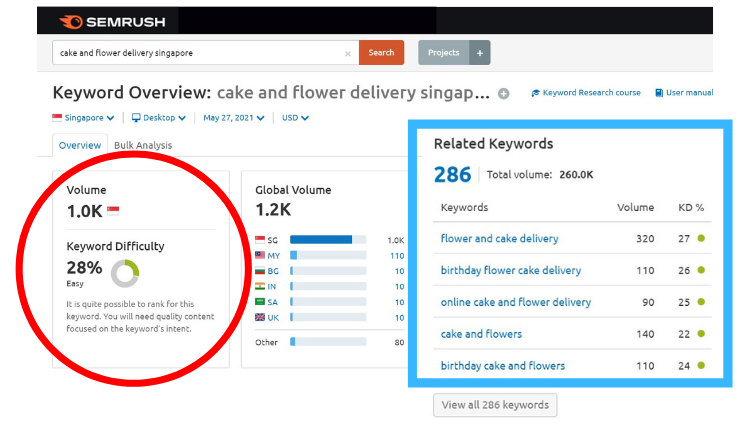
Over in the red circle we can see that although the average monthly search volume has dropped to 1,000 searches, the keyword difficulty is relatively low. Semrush also tells you that it is quite possible to rank for this keyword with quality content focused on the keyword’s intent.
Although the average monthly search volume is 1,000, it’s better for these 1,000 eyeballs to see your content compared to 22,000 never seeing your content since you can’t rank well due to high keyword competition.
Therefore, this low difficulty long-tail keyword “cake and flower delivery singapore” is worthy and an ideal keyword for your content creation and page optimization efforts.
With this, we finish our masterclass on how to do keyword research for SEO effectively.


